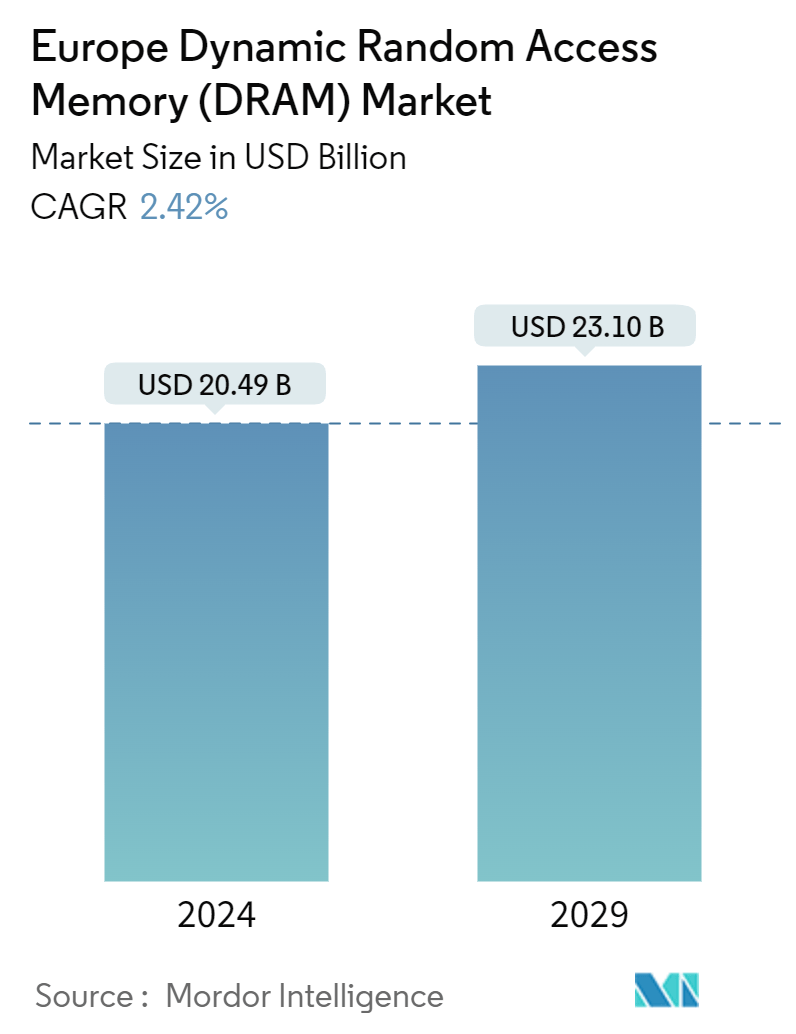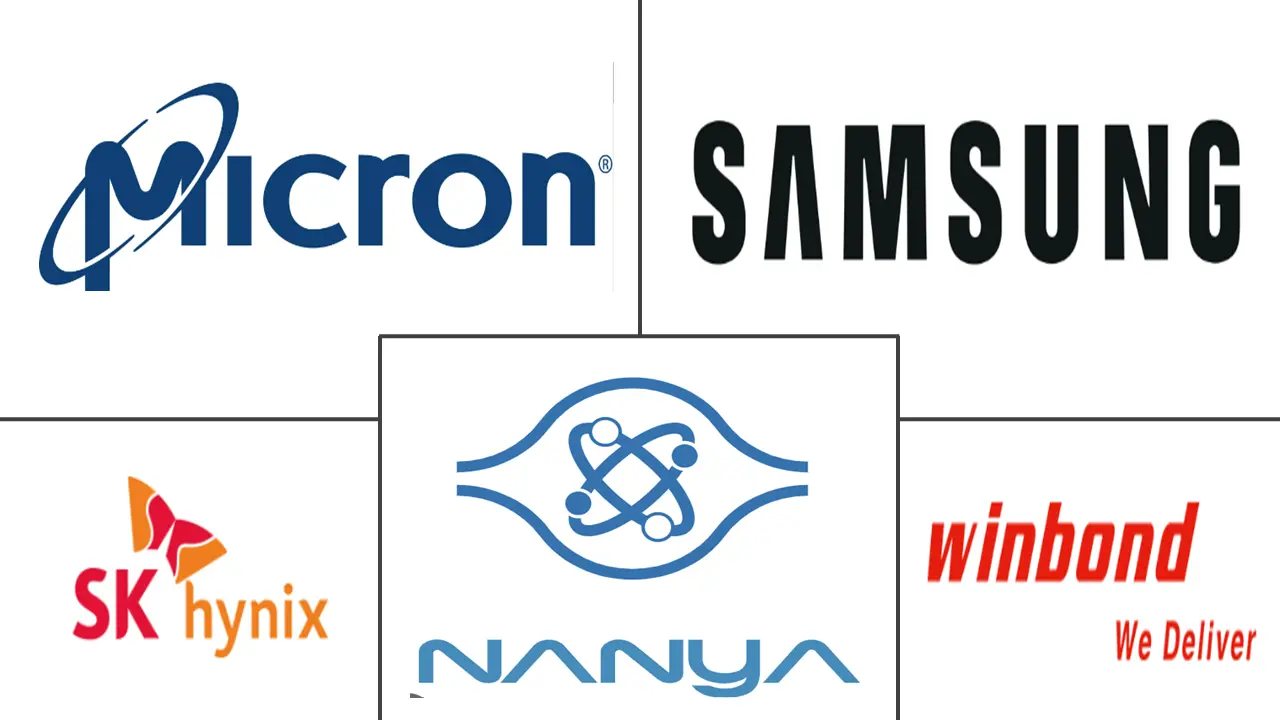Market Size of Europe Dynamic Random Access Memory (DRAM) Industry

| Study Period | 2019 - 2029 |
| Base Year For Estimation | 2023 |
| Market Size (2024) | USD 20.49 Billion |
| Market Size (2029) | USD 23.10 Billion |
| CAGR (2024 - 2029) | 2.42 % |
| Market Concentration | Low |
Major Players
*Disclaimer: Major Players sorted in no particular order |
Europe Dynamic Random Access Memory (DRAM) Market Analysis
The Europe Dynamic Random Access Memory Market size is estimated at USD 20.49 billion in 2024, and is expected to reach USD 23.10 billion by 2029, growing at a CAGR of 2.42% during the forecast period (2024-2029).
The need for cloud computing and a high-speed connection is projected to drive growth in the dynamic random access memory (DRAM) market, especially for regional data centers. Solutions with high memory density and low power consumption meet the demands of cloud computing services for high-speed data transfer, cooling, and backup.
- Since they are regularly found in 3D games, personal computers, laptops, and equipment that play high-definition movies, several major industry manufacturers are even focusing on developing new graphics DRAM chips with faster speeds and greater power efficiency.
- Europe has a burgeoning market for data centers. The amount invested in data centers in Europe is breaking records due to the surge in demand. The FLAP areas (Frankfurt, London, Amsterdam, and Paris), where the bulk of demand is sought, remain the leading data center markets. The need is skyrocketing and is increasing. Large markets like Frankfurt and London have seen an increase in foreign direct investment.
- However, colossal cloud providers and internet companies that use hyperscale data centers account for a substantial portion of the demand. These emerging trends may propel the market's growth in the region.
- According to the EU Chips Act, Europe is promoting the capacity of advanced semiconductor products and tools. The most recent generation of AI applications, computers, data centers, smartphones, supercomputers, and memory depend on advanced node processors. In contrast, trailing node chips are largely required by the automotive sector, home appliances, medical equipment, and most industrial facilities. This trend may also be effective in the market's growth during the projected period.
- During the COVID-19 pandemic, PCs, tablets, and mobile phone sales declined drastically. Consequently, the demand for DRAM manufacturing was also impacted. As the demand declined in the market, the price of DRAM increased, which was one of the restraints for the market's growth in the region.
Europe Dynamic Random Access Memory (DRAM) Industry Segmentation
The information or software code that a computer processor needs to operate is often stored in dynamic random access memory (DRAM), a type of semiconductor memory. Personal computers (PCs), workstations, and servers frequently employ DRAM. Instead of moving through the memory sequentially from the beginning, random access enables the PC processor to directly access any area of the memory. Compared to storage devices like hard disc drives and solid-state drives, RAM is housed close to a computer's processor and allows quicker data access.
Europe's dynamic random access memory (DRAM) market is segmented by architecture (DDR3, DDR4, DDR5, and DDR2), application (smartphones/tablets, PCs/laptops, data centers, graphics, consumer products, and automotive), and country (United Kingdom, Germany, France and Rest of Europe). The market sizes and forecasts are provided in terms of value in USD for all the above segments.
| By Architecture | |
| DDR3 | |
| DDR4 | |
| DDR5 | |
| DDR2/Others |
| By Application | |
| Smartphones/Tablets | |
| PCs/Laptops | |
| Data Centers | |
| Graphics | |
| Consumer Products | |
| Automotive | |
| Other Applications |
| Country | |
| United Kingdom | |
| Germany | |
| France |
Europe Dynamic Random Access Memory (DRAM) Market Size Summary
The European dynamic random access memory (DRAM) market is poised for growth, driven by the increasing demand for cloud computing and high-speed connectivity, particularly in regional data centers. The market is characterized by a focus on solutions that offer high memory density and low power consumption, essential for meeting the demands of cloud services. The proliferation of data centers in Europe, especially in key areas like Frankfurt, London, Amsterdam, and Paris, is a significant factor contributing to market expansion. These regions are witnessing record investments due to the rising demand for data storage and processing capabilities. The market is further bolstered by advancements in DRAM technology, with major manufacturers like Samsung and Micron introducing innovative products that enhance speed and efficiency, catering to applications in gaming, personal computing, and high-definition media.
The market landscape is highly consolidated, dominated by global players such as Samsung Electronics, Micron Technology, and SK Hynix, who are continuously striving to deliver cutting-edge DRAM solutions. The European Union's initiatives, such as the EU Chips Act, aim to enhance the region's semiconductor capabilities, supporting the growth of advanced node processors essential for AI applications, data centers, and other high-tech sectors. Despite challenges like the COVID-19 pandemic impacting demand and pricing, the market is expected to benefit from government support and investments in infrastructure. The UK's focus on self-sufficiency in the semiconductor industry and the growing number of mobile connections further underscore the region's potential for DRAM market growth during the forecast period.
Europe Dynamic Random Access Memory (DRAM) Market Size - Table of Contents
-
1. MARKET INSIGHTS
-
1.1 Market Overview
-
1.2 Industry Attractiveness - Porter's Five Forces Analysis
-
1.2.1 Bargaining Power of Suppliers
-
1.2.2 Bargaining Power of Buyers
-
1.2.3 Threat of New Entrants
-
1.2.4 Threat of Substitute Products
-
1.2.5 Intensity of Competitive Rivalry
-
-
1.3 Macro-economic Analysis of the Market
-
-
2. MARKET SEGMENTATION
-
2.1 By Architecture
-
2.1.1 DDR3
-
2.1.2 DDR4
-
2.1.3 DDR5
-
2.1.4 DDR2/Others
-
-
2.2 By Application
-
2.2.1 Smartphones/Tablets
-
2.2.2 PCs/Laptops
-
2.2.3 Data Centers
-
2.2.4 Graphics
-
2.2.5 Consumer Products
-
2.2.6 Automotive
-
2.2.7 Other Applications
-
-
2.3 Country
-
2.3.1 United Kingdom
-
2.3.2 Germany
-
2.3.3 France
-
-
Europe Dynamic Random Access Memory (DRAM) Market Size FAQs
How big is the Europe Dynamic Random Access Memory (DRAM) Market?
The Europe Dynamic Random Access Memory (DRAM) Market size is expected to reach USD 20.49 billion in 2024 and grow at a CAGR of 2.42% to reach USD 23.10 billion by 2029.
What is the current Europe Dynamic Random Access Memory (DRAM) Market size?
In 2024, the Europe Dynamic Random Access Memory (DRAM) Market size is expected to reach USD 20.49 billion.

